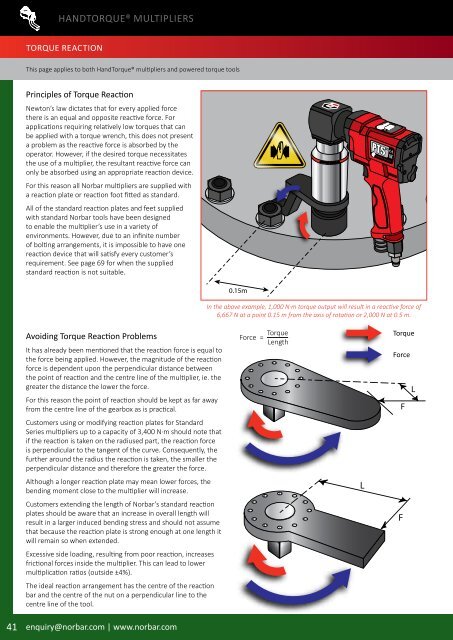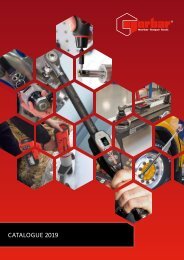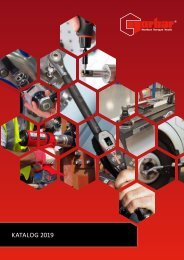Norbar Catalogue 2019
Create successful ePaper yourself
Turn your PDF publications into a flip-book with our unique Google optimized e-Paper software.
HANDTORQUE® MULTIPLIERS<br />
TORQUE REACTION<br />
This page applies to both HandTorque® multipliers and powered torque tools<br />
Principles of Torque Reaction<br />
Newton’s law dictates that for every applied force<br />
there is an equal and opposite reactive force. For<br />
applications requiring relatively low torques that can<br />
be applied with a torque wrench, this does not present<br />
a problem as the reactive force is absorbed by the<br />
operator. However, if the desired torque necessitates<br />
the use of a multiplier, the resultant reactive force can<br />
only be absorbed using an appropriate reaction device.<br />
For this reason all <strong>Norbar</strong> multipliers are supplied with<br />
a reaction plate or reaction foot fitted as standard.<br />
All of the standard reaction plates and feet supplied<br />
with standard <strong>Norbar</strong> tools have been designed<br />
to enable the multiplier’s use in a variety of<br />
environments. However, due to an infinite number<br />
of bolting arrangements, it is impossible to have one<br />
reaction device that will satisfy every customer’s<br />
requirement. See page 69 for when the supplied<br />
standard reaction is not suitable.<br />
0.15m<br />
In the above example, 1,000 N·m torque output will result in a reactive force of<br />
6,667 N at a point 0.15 m from the axis of rotation or 2,000 N at 0.5 m.<br />
Avoiding Torque Reaction Problems<br />
It has already been mentioned that the reaction force is equal to<br />
the force being applied. However, the magnitude of the reaction<br />
force is dependent upon the perpendicular distance between<br />
the point of reaction and the centre line of the multiplier, ie. the<br />
greater the distance the lower the force.<br />
For this reason the point of reaction should be kept as far away<br />
from the centre line of the gearbox as is practical.<br />
Customers using or modifying reaction plates for Standard<br />
Series multipliers up to a capacity of 3,400 N·m should note that<br />
if the reaction is taken on the radiused part, the reaction force<br />
is perpendicular to the tangent of the curve. Consequently, the<br />
further around the radius the reaction is taken, the smaller the<br />
perpendicular distance and therefore the greater the force.<br />
Although a longer reaction plate may mean lower forces, the<br />
bending moment close to the multiplier will increase.<br />
Customers extending the length of <strong>Norbar</strong>’s standard reaction<br />
plates should be aware that an increase in overall length will<br />
result in a larger induced bending stress and should not assume<br />
that because the reaction plate is strong enough at one length it<br />
will remain so when extended.<br />
Excessive side loading, resulting from poor reaction, increases<br />
frictional forces inside the multiplier. This can lead to lower<br />
multiplication ratios (outside ±4%).<br />
The ideal reaction arrangement has the centre of the reaction<br />
bar and the centre of the nut on a perpendicular line to the<br />
centre line of the tool.<br />
41 enquiry@norbar.com | www.norbar.com<br />
Force = Torque<br />
Length<br />
L<br />
Torque<br />
Force<br />
L<br />
F<br />
F







